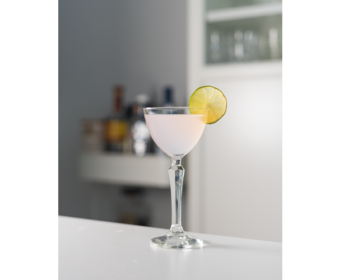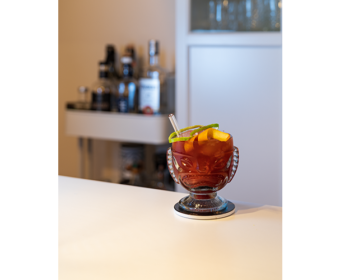Ultimate Guide to Blood Oranges Eau de Vies
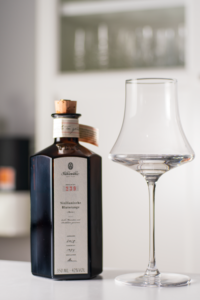
As promised in my article on the Spiritus Rex Bloody O, I wanted to take a closer look at other blood orange eau de vies out there. Since a lot of distilleries discovered this Mediterranean fruit for them, I ended up with 14 different ones to try. All of them come from Austria or Germany, with a surprising number of Austrian ones being distilled from fermented blood oranges. So, let us take a look at the taste differences.

First, let me just mention a thing I always cannot stress enough when it comes to this sort of tastings: The taste and ratings are highly subjective. While for me all blood orange distillates were good and had a more or less distinct blood orange taste. Things might be different when you taste them or when doing a blind-tasting. As mentioned above I tried 14 different blood oranges spirits with nine being distilled from fruits macerated in neutral alcohol and five of them distilled from a blood orange mash. The latter would be called a “Brand” in German contrary to a “Geist”. I split the different spirits into five flights according to their category and their price.
“Entry level” blood oranges
The first three blood orange spirits have a price per litre below 80 €. The Faude Blutorange is very well known in the German bar community and also one of my favourites when it comes to mixing drinks with blood orange spirits. It is distilled from organic Tarocco di Catania blood oranges. The Hiebl Blutorangen Geist is a vintage bottling from 2018. The third one in this flight comes from Mecklenburg-Western Pomerania. The Männerhobby Blutorange is distilled from Demeter quality Moro blood oranges which are macerated at different temperatures.
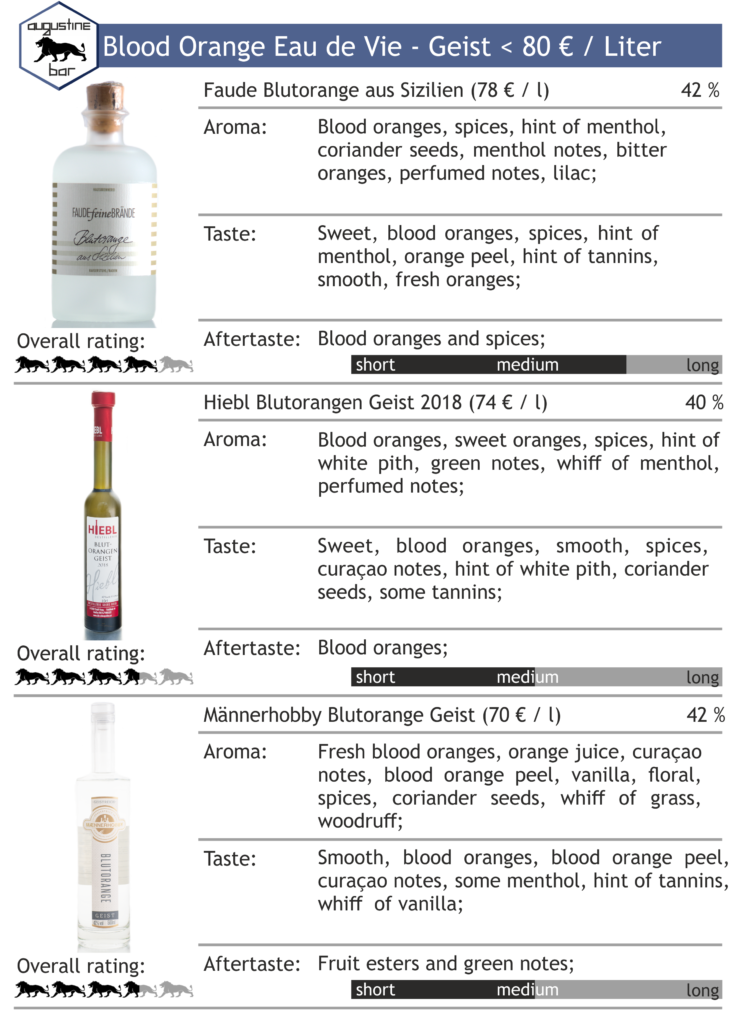
The Faude, although I have the bottle open quite some time, still is the value-for-money benchmark. The spirit has a balanced mix of blood orange, citrus, spices, and floral notes. The Hiebl Blutorange, although while true to the fruit, is a little thinner than the Faude. This is also true for the Männerhobby, but you can also detect the blood oranges in the flavour with additional notes of woodruff.
The upper middle class
The next flight consists of four different blood orange eau de vies with a price tag lower than 125 € per litre. As you might have guessed by now, the blood orange spirits are a price thing to indulge in. This is partly due to the high prize of the blood oranges and also due to the labour-intensive production. The Baumgartner Orangengeist (Blutorange) comes from renown distiller Fridolin Baumgartner, who, together with Georg Hiebl, earned the most gold medals at the famous Destillata spirits competition. His blood orange eau de vie also earned a silver medal at the 2020 Craft Spirits Fair in Berlin. A relatively new distiller on the scene is Manuel Engel he started his distillery in 2017. Manuel’s uses organic Moro blood oranges from Sicily for his eau de vie, and he macerates the peels and the flesh of the oranges separately. The organic blood orange earned a gold medal at the 2019 Craft Spirits Fair. Peter Day from the Mühle 4 distillery also makes a blood orange eau de vie from Sicilian blood oranges. Last, but not least the Satoshi Geist – Sizilianische Blutorange comes from the folks behind the Satoshi Gin. From their annual Moro blood orange delivery the guys only use the best fruits for their eau de vie.
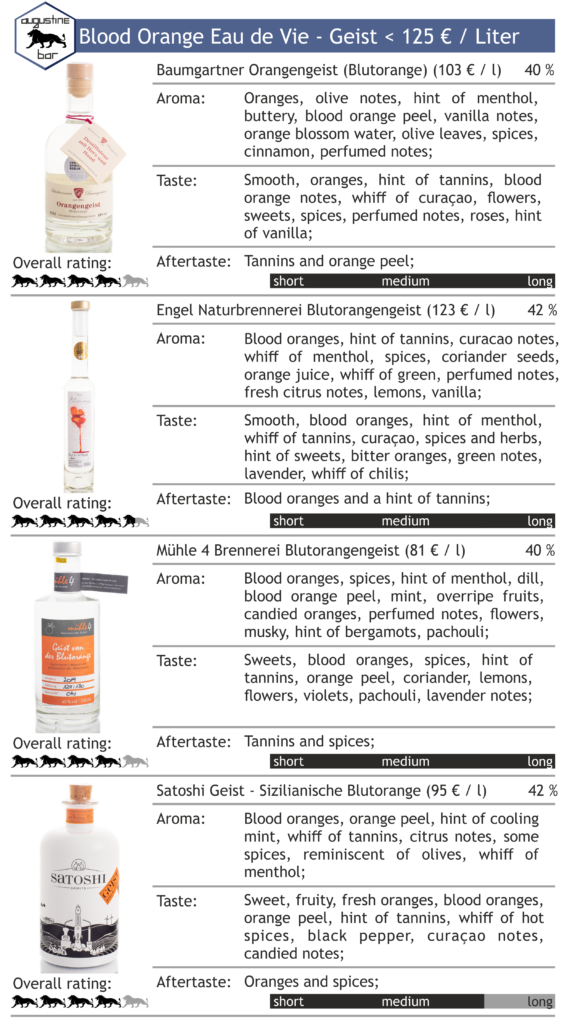
The Baumgartner Blood Orange spirit needs a little time in the glass to open up. However, after a while it shows complex flavours and tends towards an umami note. Contrary to that, the Engel greatly emphasizes the full fruitiness of the oranges with juicy and perfumed aromas. The Mühle 4 is spicy and perfumed with an interesting patchouli flavour. However, in comparison the blood orange note is a little subdued. The Satoshi polarizes, you either love its taste tending towards fruit esters, or you do not. Either way, for their second run at a blood orange eau de vie, the Satoshi team did a great job.
Pure luxury
Next up the price range further extends with the Spirits Rex and the almost celestial Stählemühle blood orange eau de vies. It is clear that those two deliver even more complex blood orange flavours. Which is further underlined, by the fact that the two spirits can handle a big nosing glass without losing flavour. Both are very similar in taste, with the Bloody O carrying more fresh citrus notes. However, this is also due to the fact that the Stählemühle bottle is open longer. On top of that, the Stählemühle has developed a distinct clementine note.
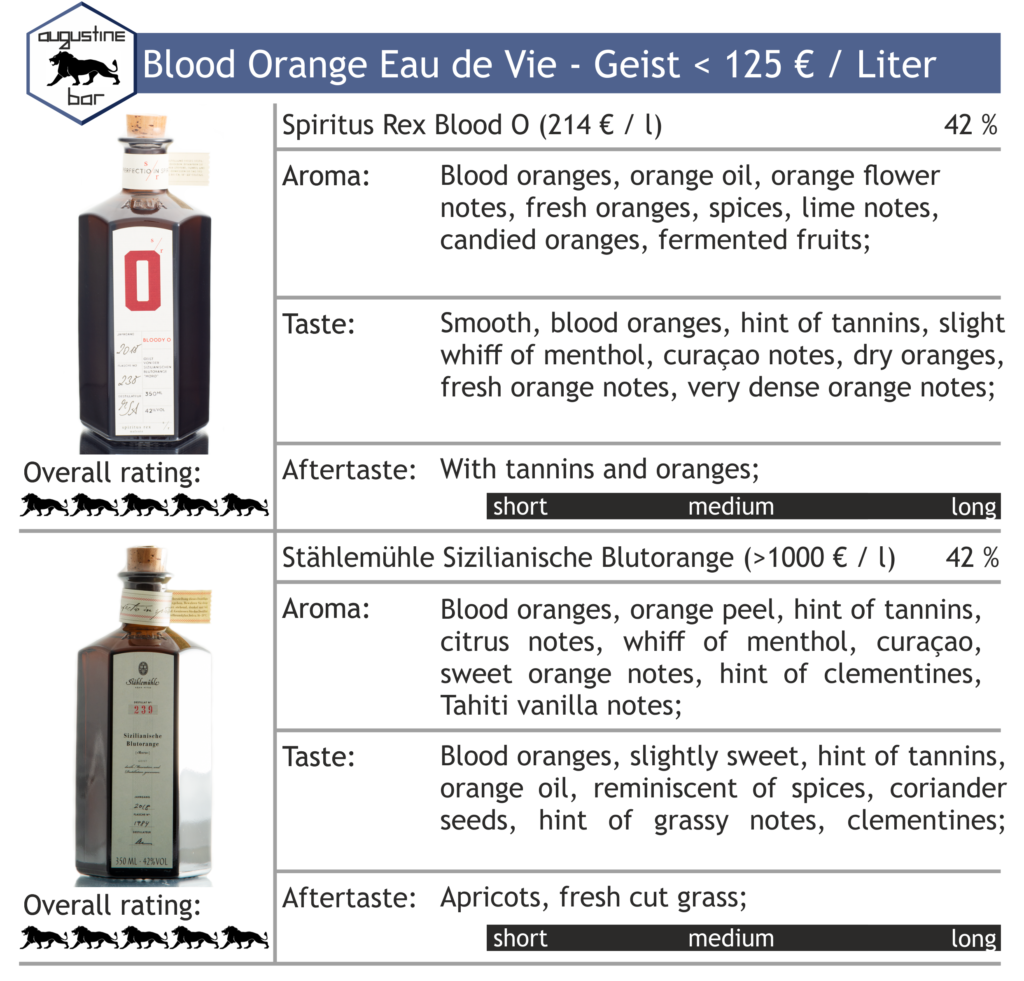
More work, more reward?
As mentioned above, I also tried five blood orange eau de vie where all the alcohol in the mash comes from the fruit itself. Since, citrus fruits do not contain a lot of fructose, you need more fruits to get a rewarding amount of distillate. In the first flight ranging up to a price per litre of 110 €, I tried the Feller Blutorange, the Herzog Blutorange, and the Sammerhof Tarocco-Blutorange. The Feller is distilled six times with only the heart of the distillate being bottled. At the Siegfried Herzog distillery, 12 kg of Sicilian blood orange flesh is fermented and then slowly distilled for each litre. The Sammerhof Blutorange was awarded with 98 Falstaff points and is distilled from Tarocco blood oranges.

Although the Feller blood orange eau de vie seems a little more neutral than the other ones, it comes with rather well-balanced kernel and overripe fruit notes. The Herzog tastes similar, but more complex and with even more marzipan-like notes. Both have in common that they have pronounced fermented fruit notes instead of the fresh orange peel aromas. Additionally, both carry certain floral or perfumed notes. In a blind-tasting you could mistake the Sammerhof blood orange brandy as a spirit distilled from macerated blood oranges. This is meant as a compliment, because the spirit manages to keep its distinct blood orange fruit note. Yet, it also takes a little time in the glass for its flavours to shine. After a while, the flavours open up and also a certain overripe fruit note develops.
Fermented luxury
Of course, you can also spend more money on blood orange spirits distilled from a fruit mash. In this case, we tried the Wiesmeier Bio-Blutorangenbrand distilled from freshly pressed and fermented blood oranges. Furthermore, we sampled the Wilhelm Marx Edelbrand von der sizilianischen bio Blutorange also made from organic fruits. The fruits are cleaned, sorted, gently mashed and distilled. Soft spring water is used for the dilution to drinking-strength.

Again, both eau de vies manage to keep the characteristic fruit notes associated with the blood orange peel. Yet, the Wiesmeier blood orange eau de vie seems slightly more complex with hints of raspberries. Therefore, the Wilhelm Marx tastes a bit fresher with juicy flavours and some tannins in the taste.
In conclusion, the differences in the blood orange eau de vies are surprising. Although all of them have some fruit characteristics, especially with the mashed and distilled spirits the essential oils from the oranges can be quite subdued. Another thing to take away from this tasting is that quality has its price. While you can also get quite good blood orange spirits for under 80 € / litre, the more you pay the more flavour you probably will be able to experience. In a following article I will present individual cocktails suited for the different blood eau de vies.
*The fact that I received products reviewed in this article for free, did not – in any way – influence the rating of said product.

